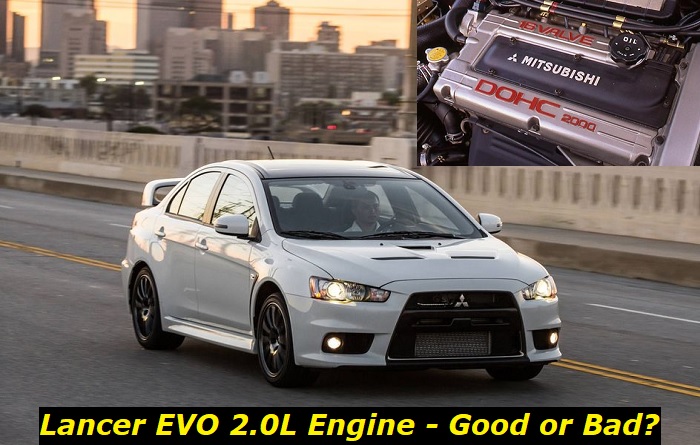It's definitely sad to see the Mitsubishi Lancer EVO go after its lengthy production run stretching from 1992 to 2016. Even so, it sure did leave a mark in the automotive landscape and has paved way for the future of other sports sedans in the tri-diamond marque.
The consensus on the Mitsubishi Lancer EVO 2.0L engine is mainly positive, but there are also valid complaints about it. Compared to the naturally-aspirated version of the powerplant, the turbocharged version used by the EVO is considered to be more prone to problems. In this article, we will confirm these allegations and show you ways how to go about them.

Key features and my opinion about the engine
- Production years:2007-2016
- Average lifespan of 4B11T:170,000-200,000 miles
- Fuel supply type:port injection
- Power range:240-445 hp
- Fuel efficiency:awful
- Engine block material:aluminum
- Engine reliability score:medium
- The most common problems:very weak timing chain, failing piston rings, phasers fail quite often, weak pulleys in the drive belt.
Mitsubishi Lancer EVO 2.0L Engine Longevity
The good thing about the 2.0L engine that used to power the final edition of the Mitsubishi Lancer EVO is that it is still being assembled up to this day. The confidence of Mitsubishi in this engine speaks a lot about its reliability in general. The low tendency of the product to develop serious problems is also a plus.
With regular maintenance, the naturally-aspirated version of the unit can last nearly 200,000 miles before requiring a rebuild or replacement according to users. The turbocharged 4B11T version may fare less because it is subjected to more rigorous use by its turbocharger but it should not be too far behind the other variant.
Most Common Problems of the Mitsubishi Lancer EVO 2.0L Engine
This section lists the most common problems experienced by a significant number of Mitsubishi Lancer EVO 2.0L engine users over the years.
1. Stretched Timing Chain
The only major complaint about the Mitsubishi Lancer EVO 2.0L engine is its noisy operation. This can be traced back to its design which relies on a timing chain instead of a belt. The noise, which can be likened to the one produced by a diesel engine, tends to be at its peak during engine warm-up. The sound normally stabilizes once the engine is at its ideal operating temperature though.
Both the naturally-aspirated and turbocharged versions of the engine are prone to this but the latter tends to get matters worse. The resulting vibrations within the unit can eventually lead to more serious issues like bore scoring as well as damage to its other internal components such as the piston rings, and valves, which will have their own discussion in the next parts of this list.
A timing chain is an important component in the Mitsubishi Lancer EVO 2.0L engine. Its purpose is to keep the crankshaft and camshafts in sync so the engine can run smoothly. The life of the timing chain usually goes all throughout the life of the engine, but it could still prematurely wear out or go out of timing if it's subjected to constant pressure due to extreme vibrations or lack of lubrication.
If the timing chain stretches or wears out, it can cause a number of problems. The symptoms of a stretched or worn timing chain include engine misfires, decreased fuel economy, and loss of power.
To diagnose the possible causes of a stretched or worn timing chain, it is important to check for any signs of wear and tear. Possible solutions include adjusting the tension on the timing chain or replacing worn parts. In some cases, it may be necessary to replace the entire timing chain assembly.
The pulleys should be checked for possible problems, too. If any of the bearings are damaged, they should be replaced. The timing chain cover should also be checked for cracks or leaks. Above all, see to it that all the part of the engine is well-lubricated to prevent such issues from happening in the first place.
If the problem is not addressed immediately, it can lead to engine damage. Therefore, it is important to take action as soon as the symptoms are noticed. By taking preventive measures, you can avoid costly repairs down the road.
2. Engine Bore Scoring
As mentioned earlier, the timing chain issue can easily lead to other damages down the road if not addressed in a timely manner. One of the possible outcomes of improper calibration of the chain or the vibrations it triggers is scoring in the engine bores. This can especially happen when the piston rings become excessively worn and damaged, causing oil to leak into the combustion chamber. The oil will then be burned along with the fuel, leading to increased carbon deposits on the bore walls. This will eventually cause the bore to score, or develop shallow grooves.
If the grooves are not too deep, they can be cleaned and evened up with a honing process. However, if they are beyond repair, the only solution is to replace the engine block. Obviously, this is a much more expensive repair than simply replacing the timing chain. So, it's important to keep an eye on the symptoms and take care of the problem as soon as possible.
The symptoms of scoring in the engine bores include increased oil consumption, loss of power, decreased fuel economy, excessive smoke from the exhaust, and knocking or rattling noises from the engine. Drive your car to a mechanic as soon as possible if you notice any of these to get a more thorough diagnosis of the problem. In some cases, simply replacing the timing chain will solve the issue. However, if the damage is already done, you may need to replace the entire engine block. Obviously, this is a much more expensive repair, so it's important to catch the problem early on.
3. Worn Piston Rings
Bad timing in the combustion chamber can trigger all sorts of problems for the engine. One of them is the premature wear of the piston rings.
Piston rings are responsible for sealing the combustion chamber and in maintaining the correct amount of oil on the cylinder walls. When they get worn out, they can no longer do their job effectively.
The symptoms of worn piston rings include loss of power, increased fuel consumption, and blue or white smoke coming out of the exhaust pipe. If the problem is not addressed immediately, it can lead to more serious problems such as a seizing engine.
To diagnose the problem, a mechanic will first check the compression in the cylinders. If it is low, then it is most likely that the piston rings are worn out. The mechanic will then take off the cylinder head to inspect the condition of the piston rings.
If you're experiencing any of the symptoms of damage in the piston rings, it's important to take your car to a mechanic as soon as possible. They will be able to diagnose the problem and recommend the best course of action. In some cases, simply replacing the said component is enough. However, if the damage is already severe, you may need to replace the entire engine block as well. Obviously, the latter is a much more expensive repair, so it's important to catch the problem from the get-go.
4. Fault in Valves
The engine valves are an important part of the Mitsubishi Lancer EVO 2.0L engine. They are responsible for controlling the flow of air and fuel into the engine cylinders. If there is a problem with the engine valves, it can cause a number of problems with the engine's performance.
Symptoms of faults in engine valves can include a loss of power, decreased fuel economy, and engine misfires. To diagnose the possible causes of the problem, a mechanic will first check for any leaks in the intake or exhaust system. They will also check the engine's compression and check the engine valves for any damage. Possible solutions to the problem can include repairs or replacements of parts, such as the intake manifold or cylinder head.
Mitsubishi Lancer EVO 2.0L Engine Key Specs
The 4B11T turbocharged engine is a version of the 4B11 naturally-aspirated engine. The 4B11T is specially designed to replace the 4G63T unit of the Mitsubishi Lancer EVO X.
The 2.0L EVO engine features an inline-four design with four valves per cylinder. It has an aluminum block and head with a bore and stroke of 86 mm. The layout allows for a compression ratio of 9.0:1.
The said configuration lets the 4B11T deliver up to 295 hp at 6,500 rpm and 300 lb-ft of torque at 3,500 rpm. Combined with the aerodynamic engineering of the Lancer EVO, the engine can drive it from 0 to 60 mph in just 4.6 seconds with its max speed capped at 155 mph.
Conclusion
The timing chain problem in the Mitsubishi Lancer EVO 2.0L engine can result in one or many things, including damage to the bores, piston rings, and valves. Therefore, be sure to use the information provided to you here to watch out for issues within these parts to prevent them from triggering more problems and save yourself from more expensive repairs down the road.
Outside of the timing chain issue shown here, the Mitsubishi Lancer EVO is generally praised for its performance and quality. With proper care and regular maintenance, you will surely get to appreciate the true potential of the car along the way.
About the authors
The CarAraC research team is composed of seasoned auto mechanics and automotive industry professionals, including individuals with advanced degrees and certifications in their field. Our team members boast prestigious credentials, reflecting their extensive knowledge and skills. These qualifications include: IMI: Institute of the Motor Industry, ASE-Certified Master Automobile Technicians; Coventry University, Graduate of MA in Automotive Journalism; Politecnico di Torino, Italy, MS Automotive Engineering; Ss. Cyril and Methodius University in Skopje, Mechanical University in Skopje; TOC Automotive College; DHA Suffa University, Department of Mechanical Engineering






Add comment